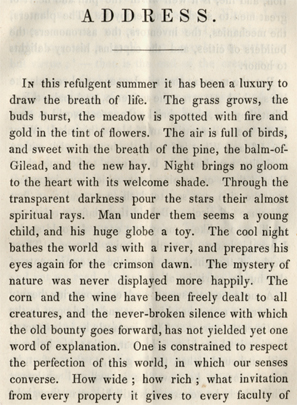 |
THE DIVINITY
SCHOOL ADDRESS, 1838
25. Ralph Waldo Emerson. An Address Delivered
Before the Senior Class in Divinity College, Cambridge, Sunday Evening,
15 July, 1838 (Boston: James Munroe and Company, 1838). Letterpress
on paper; half bound in light brown morocco and marbled paper boards; original
printed blue paper wrapper retained. Myerson A7.1. From the Emerson
collection of William Taylor Newton, presented by Edith Emerson Forbes
and Edward Waldo Emerson, 1918.
In March, 1838, a committee of three students at the Harvard Divinity School—George F. Simmons (who would later become a member of Emerson’s extended family by marrying Mary Ripley, a granddaughter of Ezra Ripley); Harrison Gray Otis Blake, who would become a major promoter of Thoreau’s work and the inheritor of the manuscripts he left at his death; and W.D. Wilson—wrote Emerson, inviting him to deliver the annual address before the graduating class at the school. Emerson spoke on July 15th before a full house. In the address, Emerson deplored the lack of vigor and meaning in established religion and urged a more direct, individual understanding of God. Man needed no “mediator or veil” between himself and God. Emerson proclaimed that the inherent unity of God, man, and nature—termed elsewhere in his writings the Oversoul—ensured each man’s potential for goodness and perfectibility toward divine virtue. Moreover, Jesus represented the highest expression of the divine spirit through the life and actions of a man, served as model and inspiration for other men, but achieved nothing beyond the capabilities of humankind in general. The Divinity School address was published in August, 1838, in an edition of one thousand copies. The entire press run was sold by the end of 1839. For obvious reasons, the address was regarded by some as a threat to established religion. It invited a more polarized response than did Emerson’s earlier offerings. Andrews Norton, a biblical scholar and professor at the Harvard Divinity School, was reactionary and vitriolic in a review for the Boston Daily Advertiser (August 27, 1838). He attacked Emerson’s insult to religion, inability to reason logically, poor taste, vagueness of expression and distortion of ideas, and the influence of the “German Barbarians” and Thomas Carlyle on his thought. Norton’s hostile criticism set off a volley of response and effected Emerson’s banishment from Harvard for decades. Even Mary Moody Emerson—the aunt who had a powerful formative influence on Emerson’s Transcendentalism, a woman of strong religious devotion and intellect, conservative in some ways and liberal in others—regretted the address. She wrote that it “should be oblivion’s, as under the influence of some malign demon.” On the other hand, some of the liberal thinkers who had been drawn to Emerson as spokesman and figurehead for Transcendentalism were deeply moved by the address. Unitarian minister Theodore Parker, present at its delivery, wrote in his journal on July 15th, “ … he surpassed himself as much as he surpassed others in a general way … So beautiful, & just, so true, & terribly sublime was his picture of the faults of the church in its present position … ” In 1839 and 1840, George Ripley—founder in 1841 of the utopian community Brook Farm—responded in a series of pamphlets to Andrews Norton’s Discourse on the Latest Form of Infidelity (1839), which was written in opposition to the ideas expressed in the Divinity School address. Emerson tried to remain above the controversy that the address generated. He continued lecturing and worked at pulling together his first collection of essays, which was published in 1841.
No image in this online display may be reproduced in any form, including electronic, without permission from the Curator of Special Collections of the Concord Free Public Library.
Next Entry - Previous Entry - Back to Section IV Contents Listing - Back to Exhibition Introduction - Back to Exhibition Table of Contents |